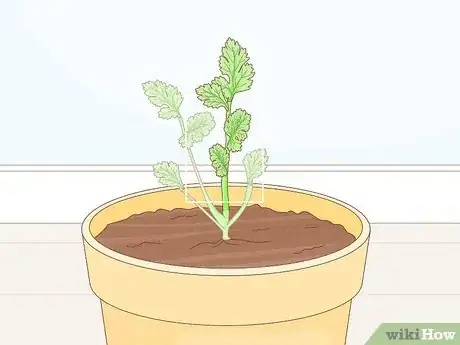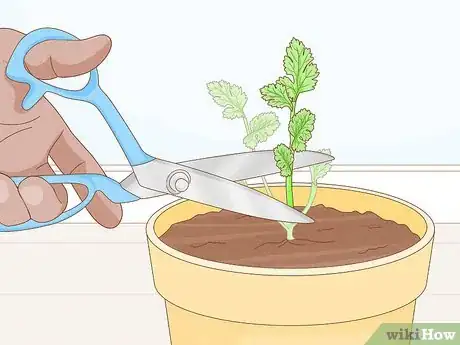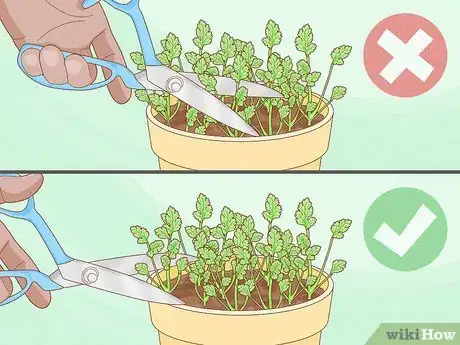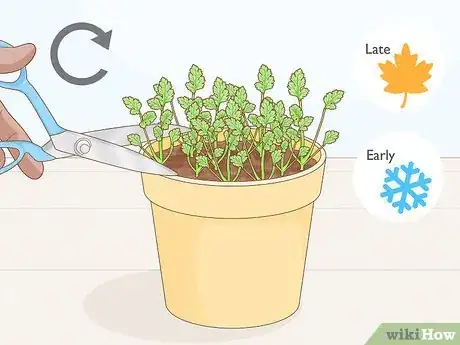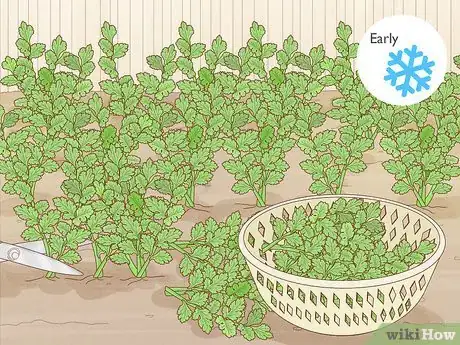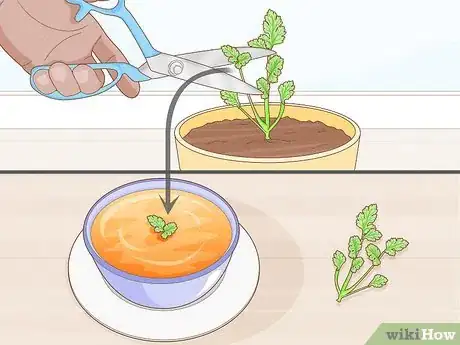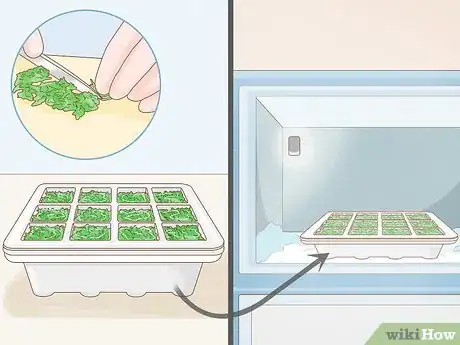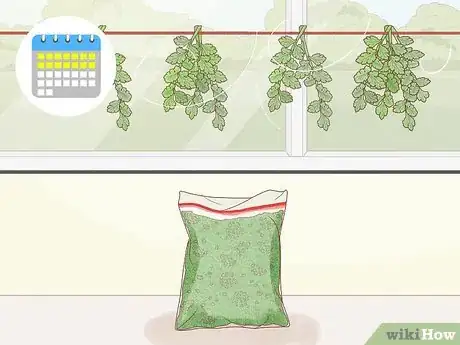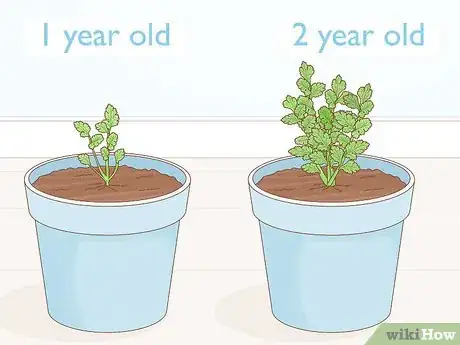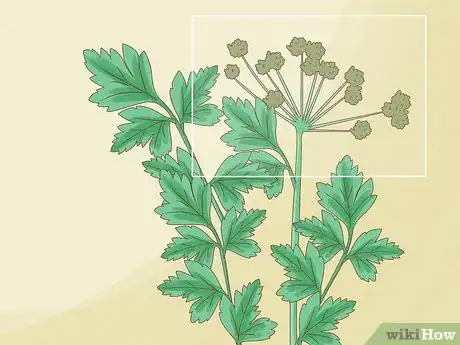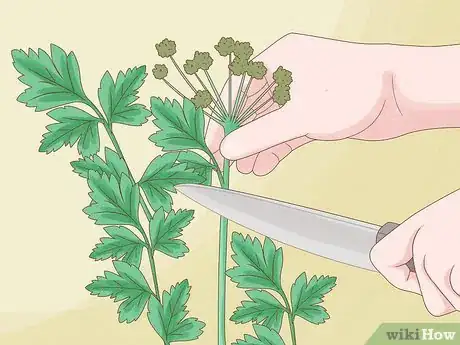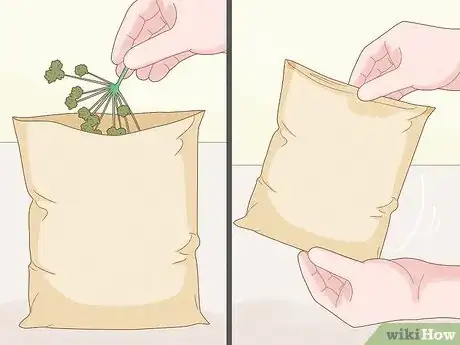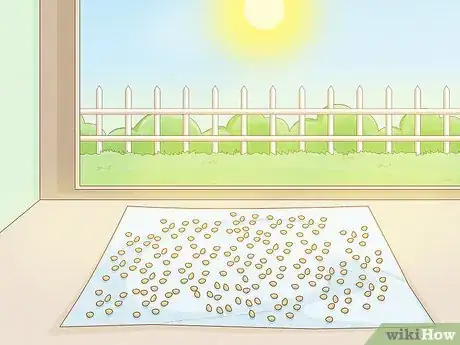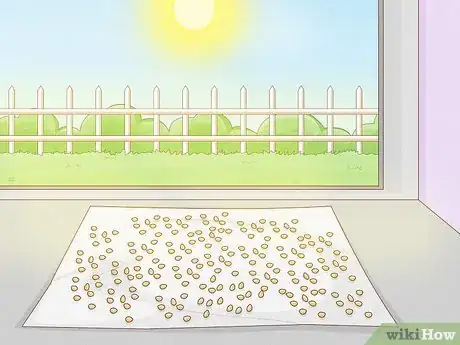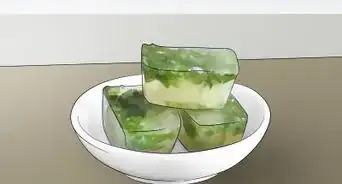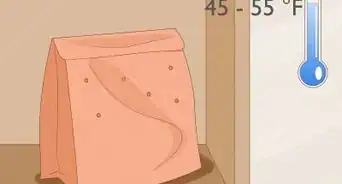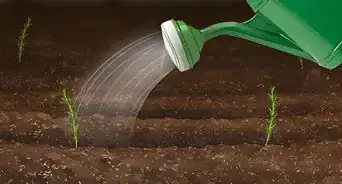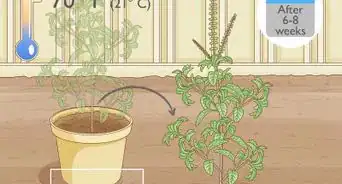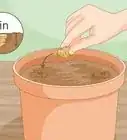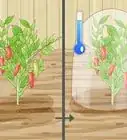This article was co-authored by Lauren Kurtz. Lauren Kurtz is a Naturalist and Horticultural Specialist. Lauren has worked for Aurora, Colorado managing the Water-Wise Garden at Aurora Municipal Center for the Water Conservation Department. She earned a BA in Environmental and Sustainability Studies from Western Michigan University in 2014.
wikiHow marks an article as reader-approved once it receives enough positive feedback. This article received 16 testimonials and 91% of readers who voted found it helpful, earning it our reader-approved status.
This article has been viewed 294,020 times.
Parsley is fairly easy to grow and even easier to harvest, but in order to get the best yield and flavor, there are a few protocols you should observe. First year parsley plants should be harvested for their leaves, while second year plants are generally harvested for their seeds.
Steps
Harvest Parsley Leaves
-
1Choose younger plants. Younger parsley plants have the strongest flavor. The leaves can be harvested even after the first year, but if you have the option of harvesting leaves from a plant in it's first year of growth, doing so will give you the best yield and product.
-
2Wait until the leaf stems have three segments. Check the stems. If the stems have three or more clusters of leaves, they are mature enough to harvest from. Stems with one or two segments should be left alone.
- Most parsley plants will be ready to harvest from within 70 to 90 days after you initially plant them.[1]
Advertisement -
3Cut at the base of the plant. When harvesting entire stems or bunches of parsley, snip the herb off at the base of the plant instead of cutting from the top.
- Cutting the parsley near the base of the plant will encourage the plant to produce even more stems, resulting in an overall bushier parsley plant with an improved yield.
-
4Cut leaves from the outer portions. If you only plan on harvesting a few small sprigs of parsley for immediate use, you should snip them off from the outer portion of the plant and not from the inside.
- Even if you plan on cutting a few full sprigs at the base of the plant, you should cut from the outside instead of the inside. The inner part of the plant will benefit from being able to mature longer.
- Removing leaves from the outside will ensure that the oldest growth is being harvested, thereby preventing it from browning or otherwise remaining on the plant too long.
- Harvesting old growth also allows the plant to focus it's energy on producing and maturing the newer growth. This effort will produce an overall healthier parsley plant.
-
5Harvest continually. Parsley will continue to grow throughout the entire season, even after you harvest the leaves. As such, you can have a steady supply of the herb and do not need to harvest it all at once.
- Parsley grown outdoors will usually remain a vibrant green until late fall to early winter. Once the color starts to fade, it's flavor will decline dramatically. Until that happens, though, you can keep harvesting the plant on an ongoing basis without a loss to the herb's flavor or health.
-
6Harvest in bulk at the end of the season. If your parsley is kept outdoors and unprotected, it will die off during the winter. Before that happens, harvest the rest of it so that the plant has a chance to grow back the following year.
- Parsley will continue to grow throughout the winter if you keep it protected in a warm place indoors. Make sure that the indoor plant receives plenty of sunlight on a daily basis by placing it near a sunny window.[2]
- If you have an indoor parsley plant, you do not need to make a final harvest before winter. Instead, continue harvesting the parsley on an "as needed" basis.
-
7Use your fresh parsley as desired. Parsley is best used fresh. It can, however, be stored for several months if necessary, but the flavor will not be as strong once you dry out the herb.
- If you cut off the leaves a little at a time, it is recommended that you use the parsley immediately. If you cut more than you can use for a single meal, wrap the rest in a damp paper towel and store them in the refrigerator for up to two days.[3]
- If you want to pull several sprigs at one time, you can place entire sprigs of parsley in water and store them in the refrigerator for up to seven days.
-
8Store your parsley in the freezer for long-term use. Freezing the parsley will allow you to keep whole sprigs for future use. Once it's defrosted, it can be used similarly to fresh parsley.[4]
- This can be accomplished in a variety of ways, but one of the easiest is to cut up the leaves into small portions and place them into ice cube trays. Fill the trays will a little water and freeze as normal. When ready to use, melt an individual cube of parsley, drain the water, and add to your dish. Note that frozen parsley will retain it's flavor but lose it's crispness.
-
9Dry your parsley for easy long-term use. Drying your parsley makes it easy to store it long-term and use it as desired. You can dry parsley by hanging full sprigs upside-down in a well-ventilated, dark, and warm area indoors. It should dry in a week or two, at which point, you should crumble the leaves and store it in an airtight bag or container.
- As another option, you can dry your herbs in a food dehydrator.
Harvest Parsley Seeds
-
1Wait until the second year. Parsley plants do not go to seed during their first year. If you plan on harvesting the seeds, you will need to monitor a plant already in it's second year.
- Parsley plants are biennial. Typically, the plants will only live for two years, and at the end of their lives, they will flower and seed.
- To maximize your seed harvest, it is recommended that you remove imperfect or weak two-year-old plants at the end of the first season. In doing so, you ensure that the healthiest plants can fertilize each other and produce good seed.
- When harvesting and storing seeds, try to separate those that were ready for harvest early from those that were ready later in the season. The seeds from early seed producers should be given priority over those that came from plants that produced seed late.
-
2Harvest the seeds when they become dark. To harvest entire seed heads, wait until the majority of the seeds have turned dark brown. If you harvest the seeds any earlier, they may not germinate well later on.
- Parsley seed goes through three basic stages. Immediately after it finishes flowering, the seed will emerge as a light or bright green color. It will eventually take on a tan tint during the second stage, and during the final stage, it will be brown or otherwise dark in color.
-
3Cut off the seed heads. Snip off the seeds by cutting directly below the seed head. Pinch the stem just below the seed head with your thumb and index finger. Cut the stem just below your fingers.
- Remove the seed heads carefully, shaking them as little as possible as you work. If you shake the seeds while clipping them off, you could end up scattering the seeds. Since the seeds are fairly small, seeds that are scattered will likely end up lost.
-
4Shake lightly. Gently shake the seed heads into a paper bag to quickly and easily remove the majority of the mature seeds.
- You could also lightly shake or tug on the seeds over a tightly woven patch of fabric or plastic sheeting.
- Shake or remove the seeds using a gentle motion. If you apply too much force, the seeds can fly off and scatter in all directions.
-
5Ripen additional seeds. If a few young seeds still remain stuck to the seed heads, you can let them ripen by setting the cut seed head out in the sun for a few days.
- To ripen more of the seeds, spread out the cut stalks on plastic or tightly-woven fabric sheets and place them in direct sunlight indoors. Keep the parsley stalks in a single, thin layer as they dry.
- The remaining seeds should be ripe within two days.
- Keep the seeds indoors as they dry. If you dry the seeds outdoors, birds or other small animals may end up getting to them before you do.
-
6Consider plucking seeds individually.[5] If a few seeds from a cluster ripen much faster than the others, you can harvest them on their own by simply pinching them off with your index finger and thumb.
- Parsley plants have a tendency to ripen at an irregular pace. Some seeds might be ready to harvest an entire three weeks earlier than others, even if the seeds are on the same plant.
- Be careful as you pluck off seeds. The force you use to pluck off individual seeds can cause the stem to recoil, and if there are too many mature seeds on the plant, they may break off with the force of that recoil and fly off as a result. As a result, it is recommended that you pluck individual seeds only if the majority of the seeds are not yet ready for harvest.
-
7Dry the seeds. The seeds will need to dry out for about 10 to 14 days before you can store them and use them later on.
- To dry the seeds, spread them out in a single layer on a baking sheet with shallow sides and place them in a warm, dry location.
- Turn and mix the seeds each day to prevent them from drying unevenly.
- The seeds must be thoroughly dry before you can store them.
- Store the dried seeds in airtight plastic bags or containers. Keep them in a cool, dry, and dark location until ready to plant.
- You can use your seeds to plant your next season's crop of parsley! Don't eat the seeds.
Expert Q&A
Did you know you can get expert answers for this article?
Unlock expert answers by supporting wikiHow
-
QuestionHI. Do you use fresh or dried parsley?
 Lauren KurtzLauren Kurtz is a Naturalist and Horticultural Specialist. Lauren has worked for Aurora, Colorado managing the Water-Wise Garden at Aurora Municipal Center for the Water Conservation Department. She earned a BA in Environmental and Sustainability Studies from Western Michigan University in 2014.
Lauren KurtzLauren Kurtz is a Naturalist and Horticultural Specialist. Lauren has worked for Aurora, Colorado managing the Water-Wise Garden at Aurora Municipal Center for the Water Conservation Department. She earned a BA in Environmental and Sustainability Studies from Western Michigan University in 2014.
Professional Gardener
-
QuestionIs it possible to ingest parsley seeds?
 Lauren KurtzLauren Kurtz is a Naturalist and Horticultural Specialist. Lauren has worked for Aurora, Colorado managing the Water-Wise Garden at Aurora Municipal Center for the Water Conservation Department. She earned a BA in Environmental and Sustainability Studies from Western Michigan University in 2014.
Lauren KurtzLauren Kurtz is a Naturalist and Horticultural Specialist. Lauren has worked for Aurora, Colorado managing the Water-Wise Garden at Aurora Municipal Center for the Water Conservation Department. She earned a BA in Environmental and Sustainability Studies from Western Michigan University in 2014.
Professional Gardener
-
QuestionHow long can I store a parsley seed head?
 Community AnswerIf you place the seeds inside of a zip-loc bag inside of a sealed glass container in your fridge, they can easily last up to three years.
Community AnswerIf you place the seeds inside of a zip-loc bag inside of a sealed glass container in your fridge, they can easily last up to three years.
Things You'll Need
Harvest Parsley Leaves
- Kitchen shears
- Paper towels (optional)
- Dish of water (optional)
- Ice cube trays (optional)
- Twine (optional)
- Airtight plastic bag or container (optional)
Harvest Parsley Seeds
- Kitchen shears
- Paper bag, plastic sheet, or tightly-woven cloth
- Baking sheet with shallow sides
- Airtight plastic bag or container
References
- ↑ http://veggieharvest.com/herbs/parsley.html
- ↑ http://www.almanac.com/plant/parsley
- ↑ http://www.hobbyfarms.com/hobby-farms-videos/harvest-parsley.aspx
- ↑ http://www.homegrown.org/forum/topics/harvesting-herbs-101-basil-chives-cilantro-coriander-mint-parsley
- ↑ http://www.urbanorganicgardener.com/2011/10/harvesting-parsley-seeds-a-simple-how-to/
About This Article
If you want to harvest parsley leaves, take leaves from younger plants to get the best flavor. Wait until the leaf stems have 3 segments, then cut the stems you want to harvest at the base of the plant to encourage more growth. Alternatively, if you're only looking for a few leaves for immediate use, cut them off from the outer parts of the plant so that the inner part has more time to mature. During the fall, harvest the rest of the leaves if your parsley grows outside so it gets the best chance to grow back in spring. To learn how to harvest parsley seeds, keep reading!

